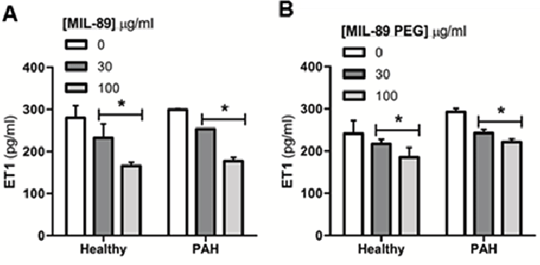Effects of the Metal Organic Frame Work (MOF) Molecule, MIL-89, on Endothelial Cell Function: Potential of MOFs as Nanomedicine Drug Carriers in Pulmonary Hypertension
Introduction: Pulmonary arterial hypertension (PAH) is a devastating disease with high morbidity and no cure1. Current PAH therapies, which include treprostinil sodium, bosentan and sildenafil, work on ubiquitous vasodilator or constrictor pathways and so are seriously limited by their systemic side effects. We therefore suggest that targeted drug delivery of PAH therapies using a nanomedicine approach would allow for higher and sustained levels of drug concentrated directly in the affected pulmonary vessels. We hypothesize that this approach has the potential to move PAH from a generally fatal conditions to a chronic manageable disease. There are a number of nanomedicine preparations but our current work focused on iron (Fe) based nanoparticle metal organic frameworks (MIL-MOFs) 2. Here we have synthesised MIL-89 and the pegylated form MIL-89 PEG, which have a central cavity size suitable to accommodate PAH drugs and it can be imaged using MRI3. We have gone on to study the effects of MIL-89 and MIL-89 PEG on human endothelial cell function of cells grown for donors with or without PAH. Methods: The nanoporous iron MOF (MIL-89), and its polyethylene glycol coated formulation (MIL-89 PEG) were prepared and characterized as previously described 2. Cytotoxicity of these MOFs was tested in endothelial cells grown from human blood progenitors from control subjects and from patients with PAH using the AlamarBlue® Assay and on endothelin (ET)-1 and CXCL8 and ET-1by ELISA. Results: Neither MIL-89 or MIL-89 PEG caused toxicity at concentrations up to 10 µg/ml with 10% reduction in cell viability only seen at the highest concentration (100µg/ml). However, both preparations of MOFs inhibited CXCL8 and ET-1 (Figure 1) release from endothelial cells from healthy donors as well as from PAH patients. Conclusion: The MIL-89 and MIL-89 PEG represent non-toxic potential drug-carriers for PAH medications. Furthermore, both MOFs show some anti-inflammatory properties in vitro. Further studies are now required to assess the effects of MIL-89 loaded with PAH drugs in both in vitro and in vivo models relevant to PAH.
Figure 1: Effect of MIL-89 (A) and MIL-89 PEG (B) on ET-1 release from endothelial cells from donors without (Healthy; n=6) or with PAH (n=4). Data are mean ± SEM. Statistical significance for the effect of MOFs was determined by one-way ANOVA followed by Dunnett’s Multiple Comparison Tests (*p<0.05).
1. Rocca D.J., et al., (2011). Acc Chem Res, 44(10): 957-968. 2. Archer S.L., et al., ( 2010). Basic science 121(18): 2045-2066. 3. Horcajada, P., et al., (2010). Nat Mater 9(2): 172-178.
|



